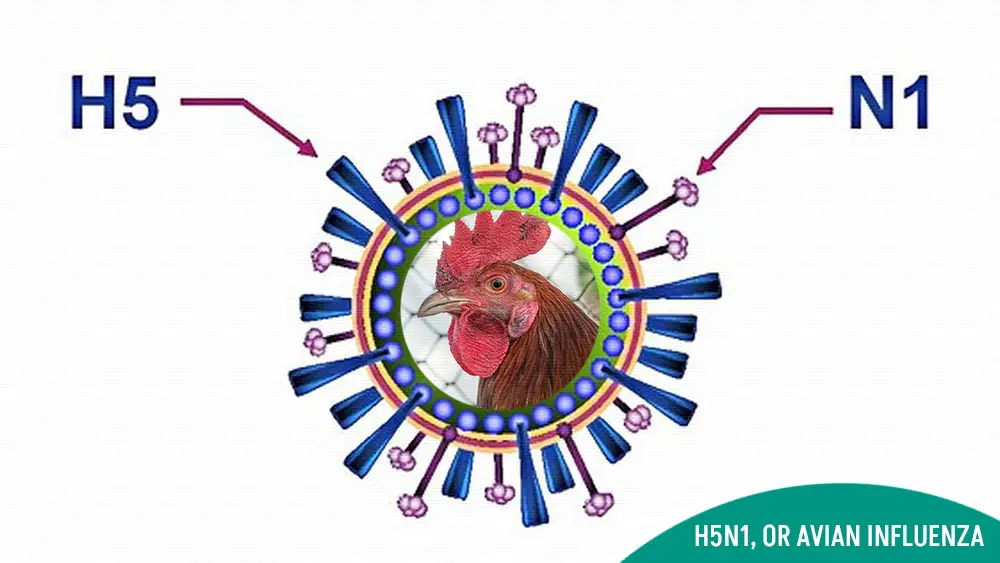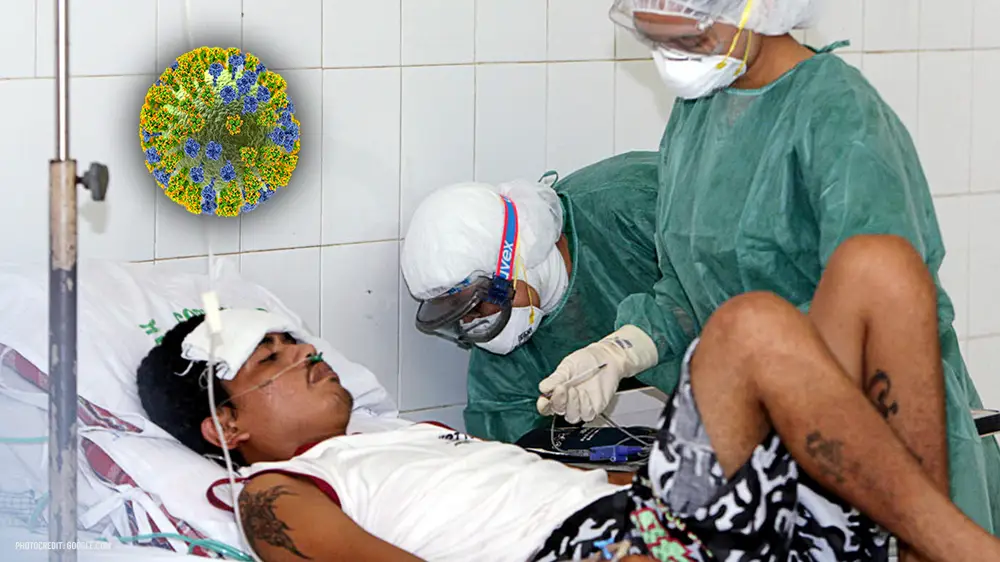
HEALTH BLOG
H5N1, or Avian Influenza Virus History, Symptoms, Treatment
-
 Rahul Priydarss
Rahul Priydarss - March 27, 2024
Explore the current status and future outlook of H5N1 avian influenza virus in this comprehensive article. Discover its symptoms, transmission, prevention strategies, recent outbreaks, and potential implications for global health. Stay informed on vaccination efforts, biosecurity measures, and international collaboration to combat this infectious disease. Learn how evolving viral dynamics and innovative approaches shape the trajectory of H5N1, guiding proactive measures for public health preparedness.
Introduction to H5N1 or Avian Influenza:
H5N1, commonly known as avian influenza or bird flu, is a highly contagious viral disease that primarily affects birds, particularly poultry. However, it can also infect humans and other animals. The “H” and “N” in its name refer to the proteins hemagglutinin (H) and neuraminidase (N) found on the surface of the virus. There are various strains of avian influenza, but H5N1 is of particular concern due to its high mortality rate in both birds and humans.
What is H5N1 or Avian Influenza:
Avian influenza viruses typically circulate among wild birds, particularly waterfowl, without causing significant illness. However, when these viruses infect domesticated birds such as chickens, turkeys, and ducks, they can result in severe outbreaks with high mortality rates. Moreover, certain strains of avian influenza have the potential to mutate and become transmissible between humans, sparking fears of a global pandemic.

Table of Contents
Origin of H5N1 or Avian Influenza Virus:
The H5N1 avian influenza virus, also known as bird flu, originated in birds, particularly wild aquatic birds such as ducks and geese. These birds serve as the natural reservoir for avian influenza viruses, where they typically circulate without causing significant illness. Over time, through genetic mutation and reassortment, various strains of avian influenza have emerged.
The specific origin of the H5N1 strain can be traced back to its first documented outbreak in 1996 in Guangdong Province, China. It is believed that the virus likely originated from wild bird populations in this region. Subsequent outbreaks and spread of H5N1 have been linked to interactions between wild birds, domestic poultry, and humans.
Factors such as intensification of poultry farming, globalization, and ecological changes have facilitated the spread of avian influenza viruses like H5N1. Human activities such as live bird markets and the movement of infected poultry have also played a role in the transmission of the virus.
History of H5N1 or Avian Influenza Virus:
The history of the H5N1 avian influenza virus is marked by its emergence as a significant threat to both animal and human health. Here’s an overview of its history.
1996-1997: The H5N1 strain of avian influenza was first identified in geese in Guangdong, China, in 1996. It quickly spread to domestic poultry, causing severe outbreaks in farms across Asia. In 1997, the virus crossed the species barrier and infected humans in Hong Kong, resulting in six confirmed cases and six deaths. To contain the outbreak, authorities culled millions of chickens in Hong Kong, effectively eradicating the virus from the region temporarily.
2003-2004: H5N1 resurfaced in Asia in late 2003, leading to widespread outbreaks among poultry in several countries, including Thailand, Vietnam, Indonesia, and South Korea. The virus continued to spread throughout Asia and beyond, infecting both wild birds and domestic poultry. Human cases were also reported, primarily among individuals who had direct contact with infected birds. The World Health Organization (WHO) raised concerns about the potential for the virus to mutate and become more transmissible among humans, potentially sparking a global pandemic.
2005-2006: The H5N1 virus spread to Europe, Africa, and the Middle East through migratory bird populations and the international poultry trade. Governments implemented strict control measures, including culling infected birds, imposing movement restrictions, and conducting surveillance to monitor the spread of the virus. Despite these efforts, H5N1 continued to circulate in bird populations, posing an ongoing threat to both animal and human health.
2007-2024: H5N1 remains endemic in many parts of Asia and continues to cause sporadic outbreaks among poultry. Human cases are relatively rare but often severe, with a high mortality rate. Efforts to control the virus include vaccination of poultry, improved biosecurity measures on farms, and surveillance to detect and respond to outbreaks promptly. Additionally, research continues into the development of vaccines and antiviral drugs for both animals and humans.
The CDC reports sporadic outbreaks in wild birds and poultry flocks globally, with a single human case confirmed in Cambodia this year [Centers for Disease Control and Prevention (CDC) on Avian Influenza (Flu)]. The current public health risk is considered low, but close surveillance of the virus is ongoing.
Spread and Transmission of H5N1 or Avian Influenza Virus:
The spread and transmission of the H5N1 avian influenza virus primarily occur among birds, particularly poultry, but it can also infect humans and other animals. Here’s how the virus spreads.
How does H5N1 spread:
H5N1, or avian influenza, primarily spreads among birds, particularly wild birds and domestic poultry. The virus can be transmitted through various means.
Direct Bird-to-Bird Transmission: Infected birds shed the H5N1 virus in their saliva, nasal secretions, and feces. Direct contact between infected and susceptible birds facilitates transmission. This can occur within flocks or among birds in the wild, especially in areas where bird populations congregate, such as water bodies.
Indirect Transmission: H5N1 virus can persist in the environment for a certain period, depending on factors such as temperature and humidity. Contaminated surfaces, equipment, and water sources can serve as reservoirs for the virus, contributing to its spread. Healthy birds can become infected by coming into contact with contaminated environments.
Human-Mediated Spread: Humans can inadvertently contribute to the spread of H5N1 through activities such as the movement of infected birds, contaminated equipment, and contaminated clothing or footwear. The international trade of poultry and poultry products also poses a risk of introducing the virus to new regions.
Transmission to Humans:
While H5N1 primarily affects birds, it can occasionally infect humans, leading to severe illness and even death. Human infections typically occur through close contact with infected birds or their secretions. Here’s how transmission to humans happens.
Direct Contact: Individuals who handle infected birds, such as poultry farmers, veterinarians, or workers in live bird markets, are at increased risk of contracting H5N1. Direct contact with infected birds or their bodily fluids, such as saliva, blood, or feces, can result in transmission of the virus to humans.
Inhalation of Contaminated Aerosols: H5N1 virus can become airborne in respiratory secretions or dust particles contaminated with virus particles. Inhalation of these aerosols, particularly in settings where large numbers of infected birds are present, can lead to human infection.
Consumption of Contaminated Poultry Products: Although rare, there have been instances where humans have contracted H5N1 through the consumption of undercooked poultry products contaminated with the virus. Proper cooking of poultry products to an internal temperature of at least 165°F (74°C) can effectively inactivate the virus and reduce the risk of transmission through consumption.
Limited Human-to-Human Transmission: While human-to-human transmission of H5N1 is rare and typically inefficient, there have been documented cases of limited transmission, particularly within close household contacts or in healthcare settings. However, sustained human-to-human transmission has not been observed, and the risk remains relatively low.
Symptoms and Effects of H5N1 or Avian Influenza Virus:
The symptoms and effects of H5N1 infection can vary depending on whether it infects birds or humans. Here’s a breakdown for both.
Symptoms in Birds:
Avian influenza, particularly the H5N1 strain, can cause a range of symptoms in infected birds. These symptoms may vary depending on factors such as the bird species, age, and overall health. Common symptoms observed in birds infected with H5N1 include.
Respiratory Signs: Infected birds may exhibit respiratory symptoms such as coughing, sneezing, nasal discharge, and difficulty breathing. These respiratory signs can be particularly severe in affected birds.
Decreased Egg Production: Hens infected with H5N1 may experience a sudden drop in egg production or produce eggs with abnormal shells or contents. This can result in economic losses for poultry producers.
Nervous System Signs: Some birds infected with H5N1 may show neurological symptoms such as depression, lethargy, weakness, paralysis, or tremors.
Swelling and Cyanosis: In severe cases, infected birds may develop swelling of the head, wattles, and comb, as well as cyanosis (bluish discoloration) of the comb, wattles, and legs due to poor oxygenation.
High Mortality Rates: H5N1 infection in birds can lead to high mortality rates, especially in susceptible species such as chickens and turkeys. Mortality rates can vary but may approach 100% in some outbreaks.
Symptoms in Humans:
Human infections with H5N1 avian influenza are rare but can be severe and potentially fatal. The symptoms of H5N1 in humans are similar to those of seasonal influenza but may progress rapidly to severe respiratory illness and multi-organ failure. Common symptoms observed in humans infected with H5N1 include.
Fever: H5N1 infection typically begins with a sudden onset of high fever, often exceeding 100.4°F (38°C).
Respiratory Symptoms: Infected individuals may experience respiratory symptoms such as cough, sore throat, shortness of breath, and chest discomfort.
Systemic Symptoms: Other systemic symptoms may include muscle aches, fatigue, headache, and malaise (generalized feeling of illness).
Gastrointestinal Symptoms: Some individuals infected with H5N1 may experience gastrointestinal symptoms such as nausea, vomiting, and diarrhea.
Progression to Severe Illness: In severe cases, H5N1 infection can progress rapidly to severe pneumonia, acute respiratory distress syndrome (ARDS), sepsis, and organ failure. The mortality rate among human cases of H5N1 infection is high, ranging from 30% to over 60%.
Severity of the Disease:
H5N1 avian influenza is considered a highly pathogenic virus in both birds and humans. The severity of the disease depends on various factors, including the host species, the virulence of the virus strain, and individual host factors such as age and underlying health conditions.
In birds, H5N1 infection can lead to severe outbreaks with high mortality rates, resulting in significant economic losses for the poultry industry. In humans, H5N1 infection can cause severe respiratory illness and multi-organ failure, with a high risk of death. However, human-to-human transmission of H5N1 is rare, and most cases occur through direct contact with infected birds or their environments.

Diagnosis of H5N1 or Avian Influenza Virus:
The diagnosis of H5N1 avian influenza virus infection involves several laboratory and clinical methods to accurately identify the presence of the virus in both birds and humans.
In Birds:
Clinical Signs and History: Veterinarians and poultry producers observe clinical signs in birds, such as respiratory distress, decreased egg production, neurological signs, and high mortality rates. A history of recent outbreaks in the area or contact with infected birds may also raise suspicion of H5N1 infection.
Post-mortem Examination: Necropsy (post-mortem examination) of deceased birds may reveal characteristic lesions in the respiratory and gastrointestinal tracts, as well as other organs. Gross pathology findings, such as hemorrhages and congestion, can provide clues for further testing.
Laboratory Testing:
- Virus Isolation: Samples collected from sick or deceased birds, such as swabs from the respiratory or cloacal tract, are used to isolate the H5N1 virus in specialized laboratories. This involves inoculating the samples into embryonated chicken eggs or cell culture systems capable of supporting virus growth.
- Molecular Detection: Polymerase chain reaction (PCR) assays can detect specific genetic sequences of the H5N1 virus in clinical samples. PCR tests are highly sensitive and specific, allowing for rapid and accurate identification of the virus.
- Serological Testing: Blood samples from birds may be tested for the presence of antibodies against H5N1 virus, indicating prior exposure or infection. Serological tests, such as enzyme-linked immunosorbent assays (ELISA), can help assess the prevalence of H5N1 in poultry populations.
In Humans:
Clinical Assessment: Healthcare providers evaluate patients presenting with symptoms of respiratory illness, fever, and other systemic symptoms. A history of exposure to sick or dead birds, poultry farms, or affected areas may raise suspicion of H5N1 infection.
Laboratory Testing:
- Nasopharyngeal Swab or Respiratory Secretions: Samples collected from the respiratory tract, such as nasopharyngeal swabs or sputum, are tested for the presence of H5N1 virus RNA using molecular methods like PCR.
- Serological Testing: Blood samples may be tested for the presence of H5N1-specific antibodies, indicating past exposure or infection. Serological assays, such as microneutralization tests or hemagglutination inhibition assays, can help confirm H5N1 infection retrospectively.
Radiological Imaging: Chest X-rays or computed tomography (CT) scans may reveal characteristic findings of viral pneumonia, such as bilateral infiltrates and ground-glass opacities, in severe cases of H5N1 infection.
Other Tests: Additional laboratory tests, such as complete blood count (CBC) and blood chemistry panels, may be performed to assess the severity of illness and monitor for complications associated with H5N1 infection.
Treatment of H5N1 or Avian Influenza Virus:
Treatment options for H5N1 avian influenza virus infection are limited, and there is no specific antiviral medication approved specifically for this strain. However, supportive care and certain antiviral drugs may be used to manage symptoms and reduce complications in both birds and humans.
In Birds:
Supportive Care: Sick birds require supportive care, including appropriate nutrition, hydration, and maintaining optimal environmental conditions. Isolating infected birds and implementing strict biosecurity measures can help prevent the spread of the virus within poultry flocks.
Antiviral Treatment: In some cases, antiviral medications approved for use in birds, such as neuraminidase inhibitors like oseltamivir, may be administered to reduce viral replication and severity of illness. However, the effectiveness of antiviral drugs in treating H5N1 infection in birds is variable, and resistance can develop over time.
Vaccination: Vaccination of poultry against H5N1 avian influenza is an important control measure to prevent outbreaks and reduce the spread of the virus. Vaccines containing inactivated or attenuated H5N1 virus strains can induce protective immunity in birds, reducing the severity of disease and decreasing viral shedding.
In Humans:
Antiviral Treatment: Antiviral medications such as neuraminidase inhibitors (oseltamivir and zanamivir) are recommended for the treatment of H5N1 influenza in humans. These drugs work by inhibiting the replication of the virus and can help reduce the duration and severity of illness when administered early in the course of infection.
Supportive Care: Supportive care measures, including rest, hydration, and fever management, are essential for managing symptoms and preventing complications in individuals with H5N1 infection. Hospitalization may be necessary for patients with severe respiratory distress or other complications.
Mechanical Ventilation: Patients with severe respiratory illness due to H5N1 infection may require mechanical ventilation or extracorporeal membrane oxygenation (ECMO) to support respiratory function and oxygenation.
Experimental Treatments: In some cases, experimental treatments such as convalescent plasma therapy or investigational antiviral drugs may be considered under compassionate use protocols or in clinical trials. These treatments aim to modulate the immune response and reduce viral replication, but their efficacy and safety in treating H5N1 infection require further evaluation.
Prevention from H5N1 or Avian Influenza Virus:
Preventing H5N1 avian influenza virus infection requires a multi-faceted approach that includes vaccination, stringent biosecurity measures, and international collaboration.
Vaccination:
- Poultry Vaccination: Vaccination of poultry, particularly domestic birds such as chickens, ducks, and turkeys, is a crucial strategy to prevent outbreaks of H5N1 avian influenza. Vaccines containing inactivated or attenuated strains of the virus are administered to poultry to induce protective immunity against H5N1 infection.
- Targeted Vaccination Campaigns: Targeted vaccination campaigns may focus on high-risk areas or regions with a history of H5N1 outbreaks. Poultry producers and farmers are encouraged to vaccinate their flocks regularly to minimize the risk of infection and reduce viral shedding.
Biosecurity Measures:
- Farm Biosecurity: Implementing strict biosecurity measures on poultry farms is essential to prevent the introduction and spread of H5N1 avian influenza virus. Measures may include restricting access to farm premises, controlling movements of people and vehicles, and maintaining proper hygiene and sanitation practices.
- Surveillance and Early Detection: Surveillance programs are established to monitor poultry populations for signs of H5N1 infection. Early detection of the virus allows for prompt implementation of control measures, including quarantine, culling infected birds, and disinfection of affected premises.
- Wild Bird Management: Given that migratory birds can serve as carriers of H5N1 virus, efforts to manage and monitor wild bird populations are crucial. This may involve habitat management, bird migration tracking, and surveillance of wild bird populations for avian influenza viruses.
International Efforts:
- Global Surveillance Networks: International organizations such as the World Health Organization (WHO), the Food and Agriculture Organization (FAO), and the World Organisation for Animal Health (OIE) collaborate to establish global surveillance networks for monitoring avian influenza viruses, including H5N1. These networks facilitate information sharing, early detection of outbreaks, and coordinated responses to prevent the spread of the virus across borders.
- Capacity Building: International efforts focus on building the capacity of affected countries to detect, respond to, and control outbreaks of H5N1 avian influenza. This includes providing training, technical assistance, and resources to enhance laboratory diagnostic capabilities, surveillance systems, and veterinary services.
- Research and Development: International research collaborations aim to improve understanding of H5N1 avian influenza virus dynamics, transmission pathways, and vaccine development. Research efforts also focus on developing novel control strategies and antiviral drugs to combat H5N1 and other emerging infectious diseases.
Recent Outbreaks of H5N1 or Avian Influenza Virus:
The most recent significant H5N1 outbreaks have involved primarily birds, with some concerning spillover to mammals and a few rare human cases. Here’s a breakdown of the situation.
Global Spread in Birds:
Since 2020, a particularly aggressive variant of H5N1 (clade 2.3.4.4b) has been causing unprecedented outbreaks in wild birds and poultry across the globe.
The virus has reached Africa, Asia, Europe, North America, and Central and South America. [World Health Organization (WHO) on Ongoing avian influenza outbreaks in animals]
In 2022 alone, 67 countries reported outbreaks to the World Organisation for Animal Health (WOAH), resulting in the culling of over 131 million domestic birds.
Wild bird die-offs have also been reported, raising concerns about the spread through migration patterns.
Spillover to Mammals:
There are increasing reports of H5N1 infections in various mammals, including foxes, otters, seals, and even some big cats.
This is concerning because mammals, particularly those that scavenge on infected birds, could act as mixing vessels for influenza viruses. This means different influenza strains could come together within a mammal and potentially create new, more transmissible viruses.
Human Cases:
Thankfully, human infections with H5N1 remain rare.
In January 2024, Cambodia reported the first two human cases this year. Both individuals likely contracted the virus through close contact with infected poultry.
The CDC reports a single human case in the US in 2023, again linked to infected birds. [Centers for Disease Control and Prevention (CDC) on Current U.S. Bird Flu Situation in Humans]
Overall, the current situation highlights the need for close monitoring of H5N1 outbreaks in birds and mammals. Public health agencies are working to mitigate the spread and prevent a potential pandemic.
Here are some resources for further updates:
World Health Organization (WHO): https://www.who.int/westernpacific/emergencies/surveillance/avian-influenza
Centers for Disease Control and Prevention (CDC): https://www.cdc.gov/flu/avianflu/index.htm
Future Prospects of H5N1 or Avian Influenza Virus:
The future prospects of H5N1 are uncertain but concerning. Here’s a breakdown of the key factors to consider.
Continued Spread in Birds: Experts predict H5N1 will likely continue circulating in wild birds for the foreseeable future. This creates a constant reservoir for the virus and the potential for further outbreaks in poultry farms.
Risk of Mutation and Spillover: The ongoing circulation and evolution of H5N1 in birds raises concerns about mutations that could enable easier transmission between humans. The recent spillover to mammals adds another layer of complexity, as it creates opportunities for different influenza strains to mix and potentially create new, more dangerous viruses.
Preparedness and Mitigation Efforts: Public health agencies are actively monitoring the situation and developing strategies to mitigate risks. This includes.
- Surveillance: Closely tracking outbreaks in birds and mammals.
- Vaccination: Developing and stockpiling vaccines specific to circulating H5N1 strains (currently not part of seasonal flu vaccines).
- Biosecurity: Implementing stricter biosecurity measures in poultry farms to prevent the spread of the virus.
- Public Awareness: Educating people about the risks of H5N1 and how to protect themselves.
The effectiveness of these efforts will significantly influence the future impact of H5N1: Possible Scenarios:
- Best-Case Scenario: Continued surveillance, vaccination efforts, and biosecurity measures effectively control the spread of H5N1, preventing a pandemic.
- Worst-Case Scenario: A mutated strain of H5N1 emerges that is easily transmissible between humans, leading to a global pandemic with potentially high morbidity and mortality rates.
The Need for Vigilance: It’s crucial to maintain close monitoring and invest in preparedness measures to minimize the risk of a future H5N1 pandemic. International collaboration is essential for effective surveillance, vaccine development, and sharing of best practices.
FAQs about H5N1 or Avian Influenza:
A1: H5N1 is a highly contagious strain of avian influenza, commonly known as bird flu, primarily affecting birds but with potential risks to humans.
A2: H5N1 spreads among birds through direct contact with infected birds or contaminated surfaces, posing a risk of transmission to humans through similar means.
A3: Symptoms of H5N1 in humans range from mild flu-like symptoms to severe respiratory illness, pneumonia, and multi-organ failure, with high mortality rates among confirmed cases.
A4: Antiviral drugs like oseltamivir and zanamivir can be used to treat H5N1 in humans, but their effectiveness may vary, and early treatment is crucial for better outcomes.
A5: Preventive measures include vaccination of poultry, implementing strict biosecurity measures on farms, international cooperation, and preparedness plans to control the spread of the virus and minimize its impact.

-Please remember, to always consult with healthcare professionals or Doctors for personalised advice related to medical conditions.
Conclusion:
H5N1, or avian influenza virus, remains a significant global health concern due to its high pathogenicity, potential for human-to-human transmission, and economic impact on agriculture and trade. Efforts to prevent, control, and mitigate the impact of H5N1 require collaboration at the local, national, and international levels.




